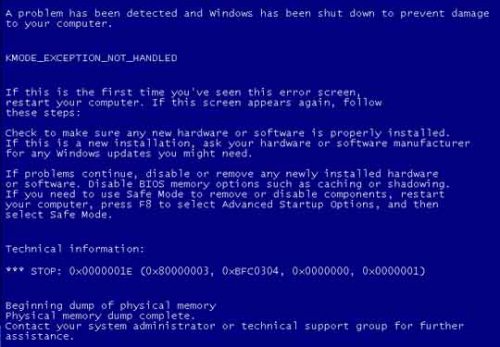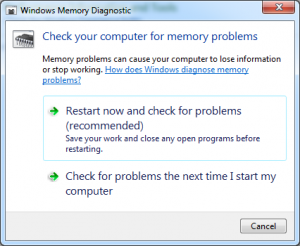| 我們致力本地化我們在盡可能多的語言的網站越好,然而這一頁是機器使用谷歌翻譯翻譯。 | 關閉 |
-
-
產品
-
資源
-
支援
-
公司
-
指南的“KMODE異常不處理”的死亡錯誤藍屏A Guide to the “KMode Exception Not Handled” Blue Screen of Death Error
通過 Steve Horton 九月 20, 2012Blue Screen of Death, bsod, KMODE_EXCEPTION_NOT_HANDLED5 Comments本文是藍屏死機錯誤系列的一部分。藍屏死機(BSoD)是Windows遇到重大問題時看到的錯誤屏幕。它會暫停PC並顯示一些非常重要的信息。
根據您收到的錯誤消息,您需要採取的步驟是不同的。
錯誤名稱:
KMODE_EXCEPTION_NOT_HANDLED
KMODE_EXCEPTION_NOT_HANDLED表示您遇到了驅動程序問題。連接到PC的某些內部或外部硬件導致驅動程序衝突或錯誤,從而導致PC崩潰。
有時,藍屏上的其他信息將列出導致問題的特定驅動程序,但情況並非總是如此。
如果確實列出了驅動程序,那麼您將要禁用它。如果沒有列出,請閱讀以下內容。
禁用特定驅動程序很棘手,但這是你如何做到的。
禁用問題驅動程序
要跟踪特定問題驅動程序,您需要運行Driver Verifier,Windows附帶的應用程序。
- 單擊開始
- 在框中鍵入驗證者 ,然後按Enter鍵
- 選擇“ 創建標准設置” ,然後單擊“ 下一步” ,再選擇“ 自動選擇此計算機上安裝的所有驅動程序
- 單擊Next ,然後單擊Finish
- 重新啟動計算機,您將看到啟動期間要驗證的驅動程序列表。如果有錯誤的驅動程序,您將收到帶有相應錯誤消息的BSOD
- 確定故障驅動程序後,請重新登錄Windows,然後通過設備管理器卸載驅動程序(參見下文)
- 單擊“ 開始”,然後鍵入verifier / reset
然後,您可以識別列出的驅動程序,並在您重新登錄Windows時將其卸載
接下來,您將要禁用驅動程序驗證,因此它不會始終在啟動時檢查。
要在識別出驅動程序後禁用它:
- 以安全模式重新啟動電腦,以便在您嘗試解決問題時避免任何進一步的藍屏死機
- 單擊開始
- 單擊控制面板
- 單擊設備管理器
- 單擊各個設備旁邊的箭頭,右鍵單擊該設備,然後單擊“ 屬性”
- 單擊詳細信息以查看驅動程序名稱。如果您看到任何帶有黃色感嘆號的設備,那麼您就是在正確的軌道上,但情況並非如此
- 另外,嘗試在Windows桌面上為驅動程序名稱執行CTRL + F以查看它所在的文件夾;這將提供驅動程序所屬設備的線索
- 找到有問題的驅動程序後,從同一屬性屏幕中單擊卸載
- Windows將嘗試從Internet提供的信息重新安裝驅動程序。這稱為即插即用。允許它這樣做
- 運行Driver Reviver以將新驅動程序更新為最新版本
運行驅動程序Reviver
或者,首先運行Driver Reviver ,然後查看將驅動程序更新到最新版本是否可以解決問題。
硬件不兼容
有時,當您嘗試在不支持它的Windows版本上使用硬件時,會發生此錯誤。如果您在收到錯誤之前剛剛安裝了新硬件,請嘗試使用Google搜索硬件的型號和您正在使用的Windows版本(例如Windows XP)來查看是否存在已知的兼容性問題。通常,某人也會發布一個解決方法,這將允許您無錯誤地使用您的設備。
BIOS或內存問題
當您的BIOS需要更新時,也會彈出此錯誤。每台PC都有不同的更新BIOS程序,因此一旦輸入,請記下BIOS製造商和版本號。重新啟動Windows和Google,以確定將BIOS更新到最新版本的正確步驟。
要運行內存測試:
- 單擊開始
- 單擊控制面板
- 在搜索框中鍵入內存
- 單擊診斷計算機的內存問題
- 保存所有打開的文件,然後單擊立即重新啟動並檢查問題 。 Windows將在重新啟動後運行內存測試,並通知您發現的任何錯誤
- 如果確實發現內存錯誤,則需要更換RAM
來自Microsoft的更多信息
這是 Microsoft網站上關於此特定BSoD錯誤的頁面。這是非常技術性的,但值得一試,如果上述解決方案不起作用。
祝你好運!
Was this post helpful?YesNo把它釘在 Pinterest 上

